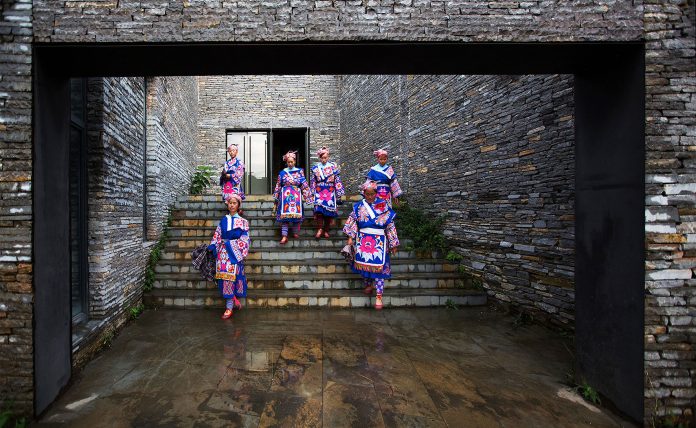Location: Chetian Village, Guizhou Province, China
Area Surface: 2357 sqm
Building surface: 715 sqm
Firm: West-Line Studio
Architecture: Haobo Wei, Jingsong Xie
Landscape: Haobo Wei, Minghua Ou
Interior: Haobo Wei, Jingsong Xie
Site Control: Haobo Wei, Minghua Ou
Construction management: Xingxing Li
Structure: Yuanping Li, Xiaoqiang Yang
Equipment: Hongbo Shi
Photo: Jingsong Xie, Haobo Wei
All Credits: West-line Studio
About West-Line Studio
The West-Line studio has been founded over ten years ago and has always been paying attention to the basic working pattern – geopolitical order + public life model + atmosphere creating + composite construction. The firm looks to keep the original status of the geographical space and the stable expression of the emotions. It even succeeds to realize a coexisting structure of place order and place the spirit in the background of the contemporary universal society, effectively protecting the humanity of the rural habitats and seeking the reconstruction method of the rural social public life in the background of the dual social structure (universal + consanguineous).
History and Stone Houses Where Tradition and Drama Meet
The cultural center is located in rural Chetian Village, in Guizhou Province, South-West China. The village was built with local materials and has more than 400 years of history is well known in the area for its stone houses. Of the 207 families living in the village, 41 belong to the Miao ethnic minority, one of the oldest minority groups in China, most of whom live in Guizhou province. Chetian Village aims to protect and promote local minorities’ traditions and its stone architecture is an important tourist attraction in the region. Ethnic minority tourists, mainly Miao and Hui, coming from nearby villages in Guizhou frequently visit the village. The square outside the cultural center, surrounded by a river, is often used as a stage for local Miao dance and drama performances and for holding traditional ceremonies. The square also serves as a vibrant meeting point for tourists and locals.
Intimate Interior Space Created by the Presence of the Stones
The architecture of the cultural center was built according to local traditional methods, using stone from the village’s pit, and is strongly characterized by 40-centimeter-thick walls. Due to its unique blue shade, the stone is commonly called ‘blue stone’. It comes from sedimentary rocks and its major components are limestone and dolomite. The local construction techniques unfortunately got lost during the passing of time. Studying the existing stone houses of the village to preserve as much as they could the traditional masonry methods, together with more modern construction technologies, the designers had to develop a new system. The intimate interior space that shows the architects’ deep respect for the historical masonry traditions of Chetian Village is created by the strong and obsessive presence of the stone.
The Aim of the Project
West-line Studio focused on creating an architecture that stands as a display by itself, without only being a place to host exhibitions about local culture and handicrafts. The original existing stone houses comprise less than a quarter of the entire village – unfortunately, most of them have been damaged or painted white. The use of the stone in the cultural center tells the history of Chetian stone culture and aims to save traditional skills that otherwise might get lost.
Construction
The construction team was directed by the head of the village and the whole project has been supported by government investments. During construction, three village heads succeed one another, and together with the different construction and extraction techniques.
Studying the existing stone houses of the village in order to preserve as much as they could the traditional masonry methods, together with more modern construction technologies, designers had to develop a new system. In order to preserve the uniqueness, every village head and his team had a different approach and different techniques themselves, starting from material extraction from the village’s pit, to the cutting until the final posing.
Each and every stone shows the trials and the mistakes, which deliberately become an active part of the architecture.
The uniqueness of every stone has sociological significance in the process of understanding the life and culture of South-West China stone villages and the entire team contributed to preserving it.






